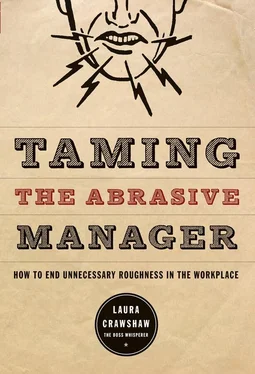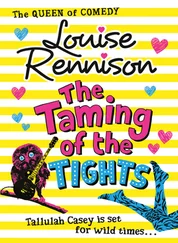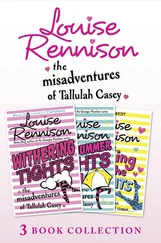Laura Crawshaw - Taming the Abrasive Manager
Здесь есть возможность читать онлайн «Laura Crawshaw - Taming the Abrasive Manager» — ознакомительный отрывок электронной книги совершенно бесплатно, а после прочтения отрывка купить полную версию. В некоторых случаях можно слушать аудио, скачать через торрент в формате fb2 и присутствует краткое содержание. Жанр: unrecognised, на английском языке. Описание произведения, (предисловие) а так же отзывы посетителей доступны на портале библиотеки ЛибКат.
- Название:Taming the Abrasive Manager
- Автор:
- Жанр:
- Год:неизвестен
- ISBN:нет данных
- Рейтинг книги:3 / 5. Голосов: 1
-
Избранное:Добавить в избранное
- Отзывы:
-
Ваша оценка:
- 60
- 1
- 2
- 3
- 4
- 5
Taming the Abrasive Manager: краткое содержание, описание и аннотация
Предлагаем к чтению аннотацию, описание, краткое содержание или предисловие (зависит от того, что написал сам автор книги «Taming the Abrasive Manager»). Если вы не нашли необходимую информацию о книге — напишите в комментариях, мы постараемся отыскать её.
Taming the Abrasive Manager — читать онлайн ознакомительный отрывок
Ниже представлен текст книги, разбитый по страницам. Система сохранения места последней прочитанной страницы, позволяет с удобством читать онлайн бесплатно книгу «Taming the Abrasive Manager», без необходимости каждый раз заново искать на чём Вы остановились. Поставьте закладку, и сможете в любой момент перейти на страницу, на которой закончили чтение.
Интервал:
Закладка:
A Bleeding Heart Is Born
Enough of the hard stuff—let’s get back to my soft-hearted goal of reducing workplace suffering caused by abrasive bosses. As I read this, I realize that I may be giving the mistaken impression that I aspire to be the Mother Theresa of executive coaching, which is not the case. I don’t do what I do because I am divinely inspired or in the least bit noble. It’s my parents’ fault—I blame them .
Too often parents are blamed for everything that we don’t like about ourselves, but I am pleased to blame my parents for teaching me that the most important use of one’s life lies in helping others. I learned about suffering from my psychiatrist father and hospital volunteer mother—not at their hands but through their hearts and eyes. I was blessed with a safe, loving home and only encountered suffering as I ventured out into the wider world.
My earliest lessons of suffering were taught by animals. When I was very little, my mother took me to a Tarzan movie where a mortally wounded elephant slowly found its way to the elephant graveyard to die. The pain and sadness that reverberated through me was excruciating—I was distraught. I remember my mother’s efforts to comfort her sobbing child, wiping my tears away, assuring me that the elephant was just acting and that it had been given a special treat of canned dog food once it finished ‘‘playing pretend.’’
A later experience of intense suffering also involved animals. I must have been six or seven years old, and my father, founder of a local children’s mental health clinic, hosted a charity carnival to raise funds for the clinic. It was a typical rainy day in Oregon, and the carnival had a kiddy ride with ponies tied to a rotating frame. I remember the wet, downcast ponies, trudging around and around in a circle of mud, and to this day the memory cuts through me like a knife. I believed they wanted to be free (or at least loved) instead of being chained to a muddy merry-go-round for human entertainment. I felt terribly sad, knowing that I could do nothing to relieve their suffering. I believe this childhood experience of helplessness in the face of suffering formed the foundation for my adult wish to reduce suffering by eventually becoming a psychotherapist and, later, an executive coach.
Intent on becoming a psychiatrist, I embarked on a premed track in college. As I wrestled with my courses, it gradually dawned on me that I was never going to succeed as a physician because, frankly, I didn’t have the patience or interest to memorize every bone, sinew, and organ of the human anatomy. I figured it would be pretty unethical to even consider the practice of medicine if I wasn’t willing to memorize everything (‘‘ I’m sorry sir, but I’m hesitant to remove your appendix because I never bothered to learn what it’s connected to ’’). I wanted to study psyche, not physique, and was fortunate enough to discover that I could become a psychotherapist without pursuing a medical degree. So I abandoned my medical pretensions and instead pursued a degree in clinical (or what was then called psychiatric) social work.
Working Wounded on the Last Frontier
Degree in hand, I moved to Seattle with the plan of paying my dues by working in respected settings and eventually opening a private practice to treat emotionally disturbed children. To that end I enrolled in the Child Therapy Certificate Program of the Seattle Institute for Psychoanalysis, where I was privileged to be clinically supervised by Edith Buxbaum, a student of Anna Freud. After two years of seeing patients in a community mental health clinic and working nights as an emergency room social worker in a major trauma center, I experienced two revelations. First, I realized that if I were to become a private practitioner, I would have to sit in a room, inside, all day, every day . Whoa— this heart not only bled, it wandered as well. The prospect of being cooped up in the same clinical stall every day made me want to hightail it out of there. Second, it became clear to me that Seattle was overrun with psychotherapists—I’d have to wait until a fair number of them dropped dead before I could have any hope of opening a viable practice. I’m not the deathwatch type, and beyond this, I was (and still am) a total tourist—I lusted to explore the wider world beyond the four walls of a clinical office. So I heeded the call of the wild, purchased a ferry ticket north to Alaska, and bolted. There were jobs aplenty in the Last Frontier, and who knew what other experiences awaited?
Within a week of my arrival, I was hired as the first full-time clinician in the first stand-alone employee assistance program (EAP) in the state, embarking on the greatest adventures any tenderfoot clinician could hope for. EAPs provide confidential counseling services to employees and eligible family members experiencing problems in their personal or work lives. Our initially tiny company eventually provided counseling to Alaskan employees (and family members) of over 600 corporations throughout the state. I was trucked up and down the Alaska pipeline in –70 ◦F (–56 ◦C) temperatures to explain the benefits of EAP counseling to pump station employees and helicoptered out to Bering Sea drill rigs to deliver the same message to exhausted roustabouts. Back at the office igloo I counseled employees on the problems they experienced at work and home, learning that shooting a spouse’s sled dogs was a reliable indicator of marital distress in Alaska. Another indicator of marital peril lay in the discovery by one newlywed that her gun-loving, hard-drinking husband’s past two wives were buried on her new love’s wilderness homestead. I referred unwilling addicted air traffic controllers into substance abuse treatment and helped wildlife biologists cope with their fears of flying. It was truly the Last Frontier—right down to the guns.
Armed Defense
The guns? I encountered the guns in the course of my counseling work. The typical scenario consisted of a call from an employee for a same-day appointment because he (they were always men) ‘‘needed to talk to someone right away.’’ We took these quiet, urgent calls seriously, reshuffling our schedules for such sudden requests. I would find myself seated across from the client, who was usually withdrawn and obviously embarrassed to be sitting in a counselor’s office. My questions of ‘‘How can I help you? Could you tell me what’s going on?’’ would elicit a halting story of suffering. The suffering was inflicted by the employee’s boss, whose behavior could take many forms, such as tyrannical control or public humiliation of the employee. The variations never failed to amaze me, but the common theme was of abrasive behavior that had pushed the employee to the point of . . . what? To find the answer, I uttered the psychotherapist’s classic question:
Counselor: And how does this make you feel?
Employee: Like getting back at him.
Counselor: Have you thought of how you would do that?
Employee: Yeah. [An embarrassed silence.] With a gun.
Counselor: Do you have a gun?
Employee: Uh . . . yeah . . . out in my truck. That’s why I called you.
The same pain that cut through me as a child when confronted with suffering now sliced through my adult soul. This man was suffering—tormented by his impulses to silence his tormentor, shamed by his loss of control, and humiliated by his need to seek external restraint for his retaliatory impulses. He had reached the point where he saw his gun as his only remaining defense against his boss’s aggression. He was one of many, and as the arsenal in our office safe increased, I wondered how this could be happening. Having experienced good parents and good bosses, I was mystified—why would bosses brutalize their employees, and how could companies tolerate this infliction of suffering? What were the dynamics of aggression and defense that created such profound anguish? These questions set this boss whisperer on a journey to understand these unmanageable managers and learn how to tame their abrasive aggression.
Читать дальшеИнтервал:
Закладка:
Похожие книги на «Taming the Abrasive Manager»
Представляем Вашему вниманию похожие книги на «Taming the Abrasive Manager» списком для выбора. Мы отобрали схожую по названию и смыслу литературу в надежде предоставить читателям больше вариантов отыскать новые, интересные, ещё непрочитанные произведения.
Обсуждение, отзывы о книге «Taming the Abrasive Manager» и просто собственные мнения читателей. Оставьте ваши комментарии, напишите, что Вы думаете о произведении, его смысле или главных героях. Укажите что конкретно понравилось, а что нет, и почему Вы так считаете.












